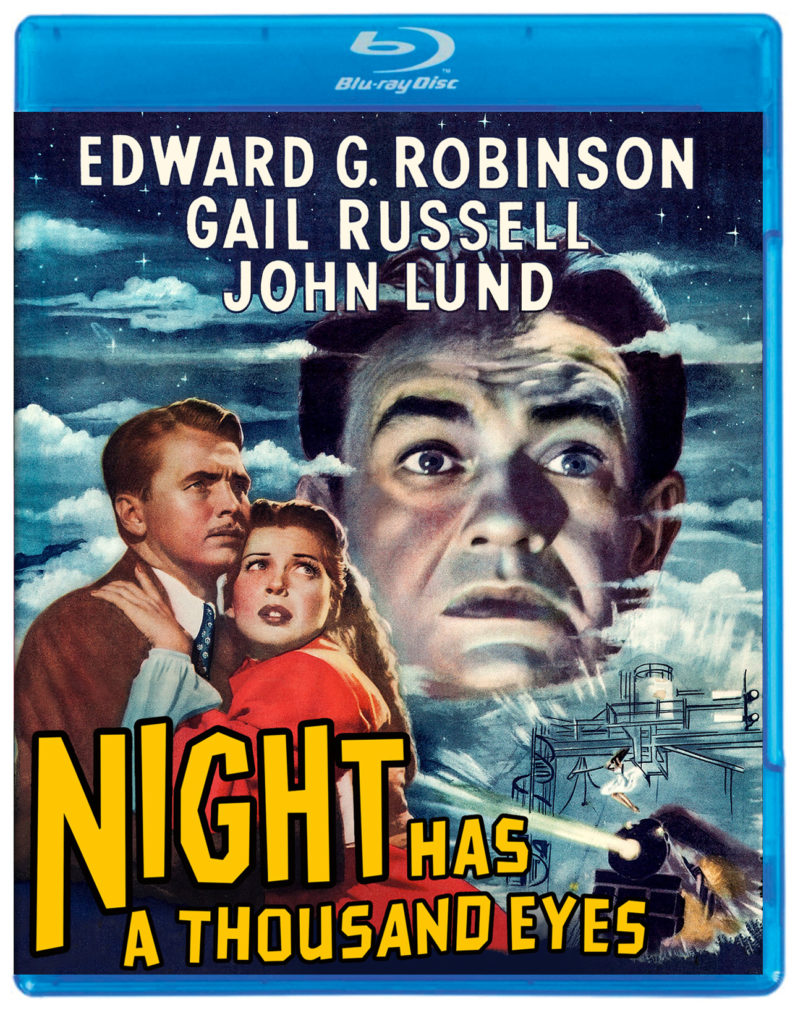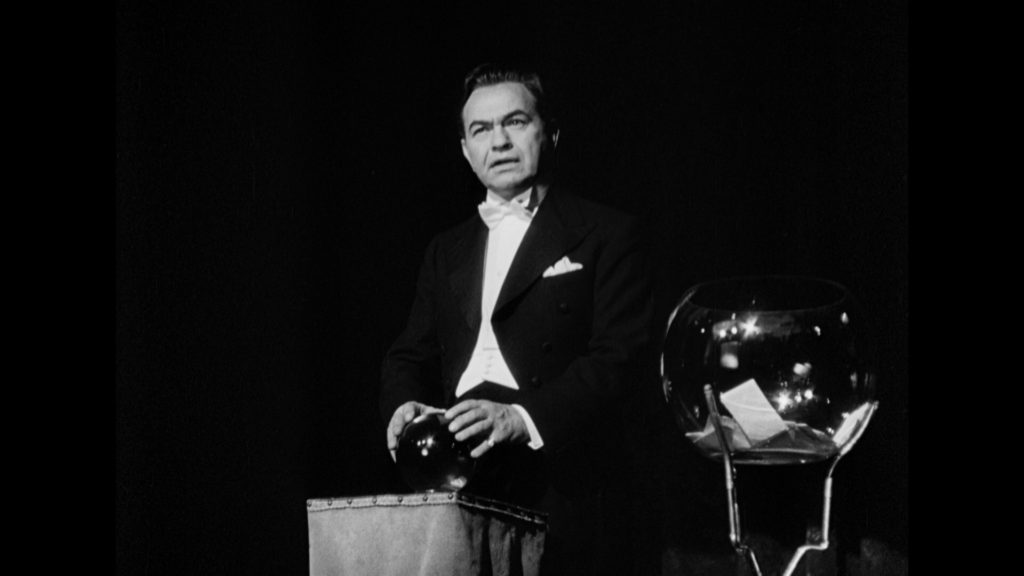Edward G. Robinson Sees All But Is Powerless To Act Under Cover Of Night.
DIRECTED BY JOHN FARROW/1948
BLU-RAY STREET DATE: NOVEMBER 2, 2021/KINO LORBER STUDIO CLASSICS

The unofficial month of Noir begins with director John Farrow’s 1948 thriller Night Has a Thousand Eyes, released by Kino Lorber this November on Blu-ray, starring Edward G. Robinson as an unwilling clairvoyant powerless to stop his dire predictions from coming true.
Film noir and the supernatural is a rare and unusual mix, but underappreciated studio director John Farrow, best known in the noir genre for previously directing 1948’s The Big Clock and later 1951’s His Kind of Woman, would also combine both in 1949’s spiritually-tinged thriller Alias Nick Beal. Superimposing the Faust legend on a late 1940’s tale of big city corruption, guilt-ridden politician Thomas Mitchell strikes a bargain with mysterious gangster Ray Milland and, through the mystical-like machinations of the unknown title character, finds he’s earned much more than merely money and power: namely, in the end, a one-way ticket to Hell. Stylized to the point of dark legend, Alias works simultaneously on two levels of reality, with the literal line of its crime story mirrored by the symbolic import of its even more sinister reflection, the waking nightmare.
Noir and nightmare drew even closer together for at least the first half of Night Has a Thousand Eyes, before, in its second part, transitioning to a more who done it?-by way of-who cares?, but nevertheless the title, with its evocation of darkness and death, never loosens its hold on its tortured main characters, particularly the tormented visionary embodied by Edward G. Robinson. At one point mid-film, Robinson as John Triton looks silently into a mirror and registers in his own reflection the full import of the nightmare his life has become since having become aware of his dubious “gift”. Able to see into the future, but unable to prevent its outcome, fantasy and reality overlap and become one, and there ultimately is no distinction between the darker corners of Triton’s mind and the coming terrors that exist for those whose doom he foresees under the cover of all-pervading night.

The film opens with one Elliott Carson (John Lund) rushing through a trainyard, frantically searching through the night for his missing fiancée, the heiress Jean Courtland (Gail Russell). Rescuing Jean just before she jumps off a bridge and into an oncoming train, Carson takes her to a nearby nightspot, a noisy Chinese restaurant, to confer with her true “rescuer”, the man who had a vision of her attempted suicide, the clairvoyant John Triton (Robinson).
There, Triton relates his lengthy backstory, and particularly his history with the Cortland family: detailing how he had worked as a (fake) mentalist two decades ago with Jean’s parents before discovering his (real) power as a psychic; and how his crystal-clear visions had both led Jean’s father Whitney (Jerome Cowan) to his eventual fortune — initially funded through Triton’s correctly predicted racetrack winnings — but had also failed to prevent Jean’s mother Jenny (Virginia Bruce) from dying in childbirth with Jean herself.
Disappearing and going underground, living in city slums and tenement districts over the next two decades — even as Whitney Cortland’s fortunes substantially rise in shipping and air transportation — Triton resurfaces twenty years later when he accidentally encounters Cortland and his now grown daughter in a crowd outside a theater. Correctly predicting Whtiney’s death due to misadventure, on a flight that Triton fails to warn Whitney against taking, Triton resolves to save Jean from the imminently approaching death he has foreseen for her under a shining field of stars.

Based on a 1945 novel by Cornell Woolrich, writing under the pseudonym George Hopley, the nightmare intensity of the writer’s worldview carries over to the substantially reworked film, with screenwriters Barré Lyndon and John Latimer shifting dramatic emphasis from the heiress to the psychic played by Robinson; the latter of whom was essentially a minor character, and more a function of the plot, in the book. Director Farrow, known stylistically for his lengthier camera takes, along with a privileged foregrounding of his protagonists against the backdrop of the story’s drama, closely follows Robinson’s eyes and facial expressions, telling the story through the actor’s anguished expressions and subtle reactions, allowing the audience to see the story unfolding in the actor’s eyes. Where, again, a brilliant actor like Robinson, as in the best silent film acting, registers the film’s tragic outcome in his own mirrored reflection, we also experience the terrible comprehension of one’s worst fears being realized both within and outside that shrouded corner of John Triton’s far-reaching mind.
But where the film may lose viewers is in its second half, when the story transitions to something like a creaky dark old house thriller in the vein of The Cat and the Canary (1927) or, indeed, The Old Dark House (1932) itself. There is a criminal “author” behind these darker, sinister goings-on under the night sky – a hand behind a curtain reaching out to turn the hands of a clock, a sinister shadow moving through the night, a figure emerging from behind a stone lion – but, despite the presence of under any other circumstances-welcome character actor William Demarest, as a skeptical police lieutenant, these creeping night maneuvers fail to engage viewers as readily, perhaps, as, say, Robinson’s Triton’s dead-eyed and tormented stare. Nevertheless, master cinematographer John F. Seitz’s visuals plunge viewers from beginning to end into the haunting nightworld that those eyes continuously register, and viewers will emerge disillusioned from the film, past its closing credits, of any daydreaming desire to see into the future. The thousand-eyed night has seen it before you have and, as always, Noir City abides.
…

Night Has a Thousand Eyes has been transferred to Blu-ray by Kino Lorber from a 2K master, which accentuates to considerable advantage the pervasive light-and-shadow in terms of both the story and the visuals. The feature-length commentary from writer, historian, and film noir expert Imogen Sara Smith also comes highly recommended for its organization and insight, balancing research and analysis in discussing and contextualizing this atypical noir. Of particular interest to this listener was how Night Has a Thousand Eyes followed and broke from the postwar context of spiritualism depicted in contemporary films like Nightmare Alley (1947) and The Amazing Mr. X (1948), and how this film, despite its fantastic elements, imbued a psychological realism to its depiction of the supernatural.
As Imogen Sara Smith’s commentary additionally observes, from a pulp fiction writer whose haunted titles frequently employed words like Dark, Black, Death, and, indeed, Night, the genre underpinnings of this vividly realized “spook” noir may remind viewers throughout its brief 81-minute running-time where the darkest corners of our souls are reflected in the all-seeing night.
Images used in this review are credited to DVDBeaver and are taken from Kino Lorber’s Blu-ray release.

